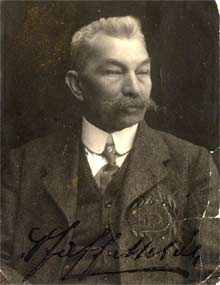
September 16, 2008
Science is the Total Perspective Vortex:
in the fictional world of Douglas Adams’s The Hitchhiker’s Guide to the Galaxy . . . allegedly the most horrible torture device to which a sentient being can be subjected . . . it shows its victim the entire unimaginable infinity of the universe with a very tiny marker that says "You Are Here" which points to a microscopic dot on a microscopic dot.
Ever since Copernicus broke the news that Earth was not the center of the universe, science, like an evolution accelerator run amok, has been in the business of kicking its host out of one comfort zone after another. No sooner have we grudgingly accepted that we cling to a speck of dust in an obscure precinct of a teeming universe than we’re forced to turn around and face the fact that we ourselves are hulking home planets to trillions of foreign microorganisms—more than our bodies have cells of their own. We’ve learned that all we do, think, and are is assembled and maintained by a frail double-threaded molecule that directs a staggeringly complex nanotechnology from the centers of our cells. And we’ve learned that those very cells are only here thinking about it—on a planet that’s more than just rock soup—because of an ancient infection that ended in a deal.
In this month’s “Life Zone,” Olivia Judson examines mitochondria, the “power plants” in our cells that appear to be the modified and integrated relics of bacteria that invaded, or were engulfed by, primitive one-celled organisms, and stayed, bartering energy for shelter. (That link leads to a lucid and charming little account of the symbiotic origin of mitochondria and other cell organelles, by a Swiss scientist who says that “evolution is inherently irreverent.” And here’s another (PDF), to the hypothesis that even the cell nucleus could have started life as a free-living organism. It’s called endosymbiosis, and that link leads to a very clear tutorial on it from the University of California at Berkeley.) Judson explains that our mitochondria show unmistakable vestiges of their bacterial past—they have a single circular chromosome, just like most bacteria, and they can multiply independently of the cell’s division—but some of their original genes have been lost, and others have migrated into the nuclear genome.
The little human mitochondrial genome, which has only thirty-seven genes compared with some 20,000 in the nucleus, has been thoroughly mapped, and Mitomap.org provides the map, along with the complete base sequence; the individual genes, their loci and functions, and the proteins they make; the most common geographic variations, deletions, insertions, and mutations; and all the known diseases associated with changes either in “mtDNA” or in the segments of nuclear DNA that are vital to mitochondrial function and replication. This amazing, no-frills site is one-stop shopping for all things mito.
Of course, mtDNA, inherited almost exclusively through the maternal line (you get your starter mitochondria in the cytoplasm of your mother’s egg), along with the males-only Y chromosome, is helping us to trace our personal ancestry through the branchings of the human family tree. In case you haven’t yet tried that—by sending a cheek swabbing to National Geographic’s Genographic Project, or to one of the more than two dozen commercial services that offer the analysis—here’s a sample Genographic Project report, which was posted online by an obliging individual. Scientists warn that private companies often overhype what their tests can tell you (sorry, you won’t find out if you’re a direct descendant of Genghis Khan); this caveat emptor article provides an invaluable look before you leap. (I’m particularly curious to try this with my husband: he comes from a group of Saxon Germans who migrated to Transylvania around 1100, where they settled right in the path of every invasion from the Asian steppes and consequently acquired a large dollop of hardy Mongolian DNA, quite likely through rape. You can see it in the chip off the old Genghis over in the sidebar, my husband’s grandfather; he was born with a “Mongolian spot,” as was my half-Mexican niece.)
That’s the good, or at least interesting, news from the mitochondrial front. The not-so-good news is that, as Judson writes, we’re learning more and more about the mitochondrial genome’s rather extreme susceptibility to mutation, and the variety of creepy and (so far) incurable diseases its slip-ups can cause. Some of these are passed from mother to child (PDF), but as that link makes clear, not in the neat Mendelian way that nuclear mutations are. (There are nuclear mutations that can mess up mitochondrial function as well, and those are inherited more predictably.) Judson reports that perhaps one in 8,500 of us suffers from the effects of inherited mitochondrial impairment—which vary widely, from muscle weakness and fatigue to seizures or blindness, depending on the organs most affected—and the only treatments so far shown to partially ameliorate some of those effects, some of the time, are . . . exercise and vitamins! But there isn’t one of us who doesn’t suffer sooner or later from the cumulative effects of mitochondrial DNA mutation and malfunction, which scientists increasingly suspect of being a major culprit in aging and many age-related diseases, including diabetes, Parkinson’s, and Alzheimer’s. Much basic research is still needed, and in 2004 a MacArthur Foundation “genius grant” was awarded to Vamsi Mootha, a Harvard systems biologist and physician who is a leader in the field.
Ouroboros, a “community weblog for biologists of aging,” reports on research into all the ways that living organisms wind down, including the likely role of mitochondria. The field of biogerontology is exploding as we humans rage and race against our confining lifespans, groping for the molecular latches that will let us out into the vastness of time and space we are now so tantalizingly able to glimpse and so eager to explore.
You Are Here.



(Annie Gottlieb) |
Comments (add yours!)

Return to September home
|


